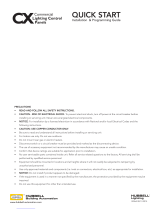
GreenMAX: Users Manual 3
Table of Contents
Table of Contents
System Introduction ................................................................................... 5
Overview .......................................................................................................................6
Structure........................................................................................................................7
Enclosure ......................................................................................................................8
Command Module .........................................................................................................9
Relays .........................................................................................................................10
Relay Insert Panels .....................................................................................................12
Handheld Display Unit.................................................................................................13
Installation - Cabinets ................................................................................ 15
Enclosure Sizes ..........................................................................................................16
Plan Installation ...........................................................................................................17
Mounting and Installation ............................................................................................18
Door and Covers .........................................................................................................19
Wiring .......................................................................................................... 21
Low Voltage Wiring - Sensing Devices .......................................................................22
Low Voltage Wiring - Switches ....................................................................................23
Emergency Input .........................................................................................................24
Network ....................................................................................................... 25
LumaCan Network ......................................................................................................26
LumaCan Network Addresses ....................................................................................27
LumaCan Network Topology .......................................................................................28
The Start-Up Process ................................................................................. 29
Overview .....................................................................................................................30
Preparation..................................................................................................................31
Interconnect the Relay Cabinet - Step 1 .....................................................................32
Interconnect the Relay Cabinet - Step 2 .....................................................................33
Interconnect the Relay Cabinet - Step 3 .....................................................................34
Interconnect the Relay Cabinet - Step 4 .....................................................................35
Connect Digital Switches ............................................................................................36
LumaCan Check List ...................................................................................................37
Firmware Upgrade - Step 1 .........................................................................................38
Firmware Upgrade - Step 2 .........................................................................................39
Programming .............................................................................................. 41
Programming Basics ...................................................................................................43
Frequently Asked Questions ..................................................................... 47
Frequently Asked Questions .......................................................................................48
Setting LumaCan Addresses ......................................................................................49
Data Cable Requirements ...........................................................................................50
Ratings ........................................................................................................ 51
Ratings ........................................................................................................................52























